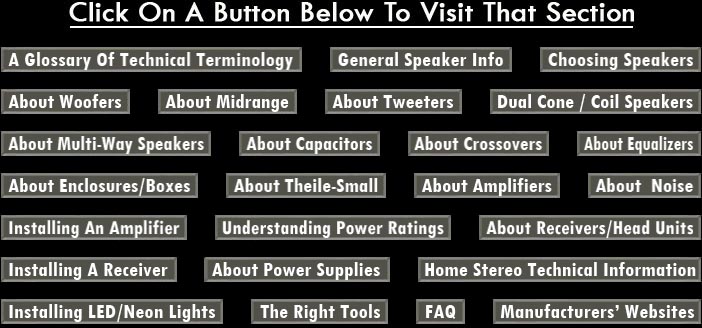


Earth
An electrical connection to the earth, which represents 0 volts or 'ground potential' by way of a metal or conductive rod.
Easter egg
A surprise "extra" coded into DVD's, computer programs or web pages that is accessed by an undocumented keystroke combination or hidden link.
EBP
Efficiency Bandwidth Product. A parameter that helps determine the suitability of a driver for a sealed or ported enclosure. An EBP of less than 50 indicates the driver should be used in a sealed box, 50 - 90 indicates flexible design options including bass reflex, over 90 indicates the need for a ported enclosure. EBP = Fs / Qes
Echo
The effect of a sound and a delayed version of that same sound. A 'Slap-Back Echo' is the original sound plus a single repeat; "Multiple Echo" is the original sound plus several repeats with the identical delay spacing and decay times.
Effect
A device which modifies sonic structures creatively with various processing techniques.
Effective Piston Area (Sd)
(measured in square inches or meters) The active radiating area of a speaker cone, including that part of the surround which displaces sufficient air to produce a measurable acoustic output.
Efficiency (see Sensitivity)
The ability of an audio system to convert electrical energy (watts) into mechanical energy (Decibels of acoustical energy). This ratio is usually given as the amount of energy measured in Decibels at a distance of one meter from the input of one watt of electrical energy. In most speakers, the greater the efficiency rating, the louder the unit will play in response to the same setting of the volume control, in comparison to less efficient types. The overall efficiency for most speakers systems is under 20 percent. Typical speakers can be rated at anywhere from 85 to 110 dB. Keep in mind, of course, that efficiency is only one parameter of a speaker's overall quality.
Electrostatic Driver
The Electrostatic Driver generates a motive force for its diaphragm by the interaction of electric rather than magnetic fields as is the case for the dynamic driver. The electrostatic driver is basically "hung" on a frame. It does NOT have a box enclosure, so a great deal of "coloration" (frequency response fluctuations caused by the enclosure reflections) is avoided. A large diaphragm of lightweight material is placed between two perforated (acoustically transparent) electrodes. The diaphragm is electrically polarized at a few thousand volts relative to the electrodes, which maintain a large electrostatic field. The audio signal is applied to the two electrodes in a push-pull fashion. Under these conditions, the diaphragm will vibrate in step with the audio drive signal and produce sound. Because it is a true push-pull driver (i.e. its diaphragm is driven from both front and rear), it operates in a linear fashion.
In an electrostatic driver, the driving force is uniform over the entire diaphragm surface (note that for the Dynamic Driver, the diaphragm is driven over a small portion of its overall surface) as a result, Electrostatic Drivers do not suffer drastically from "breakup" effect as dynamic drivers. Gross distortion typically results only if the driving amplifier clips into the speaker, or when, in an attempt to play the driver at a higher sound level than its design permits, its step-up transformer may reach a point of saturation. Due to the diaphragm of the electrostatic driver being of low mass (lightweight), its transient response is excellent and reproduction of subtle, low-level musical details is exceptional.
Electrolytic Capacitor
A polarized capacitor with a negative and a positive terminal that is commonly used for DC power filtration and energy storage. As with all capacitors, the dielectic insulator separates two plates and holds a charge. In this case the dielectric is a form of chemical electrolyte that is polarized. Smaller types are mesured in microfarads while the large ones used for amplifier stabilization are measured in farads. Values in the range of .5 to 3 farads are typical for use with car audio amplifiers.
Enclosure, or Box
A cabinet in which the various Drivers are housed. This arrangement is absolutely essential if bass response is desired from the woofer, which by itself in the open air, will produce very little low frequency response. This is so because of an effect called phase cancellation. This means that the sound wave coming from the back of the speaker at low frequencies is identical in form and intensity to the one coming from the front of the cone. When they meet, as in the open air, they are exactly 180 degrees out of phase and thus cancel each other out. An enclosure either prevents this from occurring or modifies the interaction so that the backwave actually reinforces the front wave. Tweeters and midranges are less severly effected by the phase cancellation effects, and are not in need of enclosures.
Enclosure Volume
The total amount of internal airspace of an enclosure. Each woofer has an optimal airspace volume that helps it meet it's bass potential. This resonance cavity specification usually measured in cubic feet, includes the net driver and vent volumes. To find the volume of a cube multiply HxWxD in inches. divide the result be 1725 (the number of inches in a cubic foot) to get the volume in cubic feet.
EQ (equalizer)
A class of electronic filter circuits designed to augment or adjust electronic or acoustic systems. Equalizers can be fixed or adjustable, active or passive. Most consumer audio equallizers divide the spectrum into 3 to 12 bands, allowing each section to be either increased or decreased in amplitude without changing the response of the rest.
In the early years of telephony and cinema, the first equalizers were fixed units designed to compensate for losses in the transmission and recording of audio signals. Hence, the term equalizer described electronic circuits that corrected for these losses and attempted to make the output equal to the input. Equalizers permit the modification the frequency response spectrum of the signal passing through them; that is, they modify the amplitude versus frequency characteristics.
Ergonomics
The accessibility and ease of controlling a system in normal operational mode with a minimum of motion and thought required.
ESP
Electronic Shock Protection. An electronic circuit that stores the audio data stream from a CD or MD in a memory buffer. If the laser pick-up mistracks, audio still flows from the buffer preventing an interruption.
Excursion
The back-and-forth travel of a cone in a dynamic Driver. How loud a speaker can play depends on how much air it can move without overheating. How much air can be moved is determined by the surface area of the cone as it moves back and forth (Xmax), the Enclosure resonance, and the suspension compliance of the motor system.
Excursion Limited Power Handling
Based on the maximum amount of power the driver can handle without appreciable distortion. All frequencies 30 Hz and above are considered in this limit.
Excursion Limited SPL
The maximum sound pressure level the system can produce given an input signal equal to the rated excursion limited power handling.
Expander
A type of dynamic range processor which reduces the gain of audio signals which are under an adjustable 'threshold' level, therefore increasing the dynamic range. Generally allows the operator control over threshold, ratio, attack, release and 'hold' times. Both analog and digital types are available.
Extended Pole Piece ( See "Bumping")
Extended pole pieces on the magnet assembly allow for more voice coil travel, and thus lower Frequency Response, and less chance of "bottoming out"















